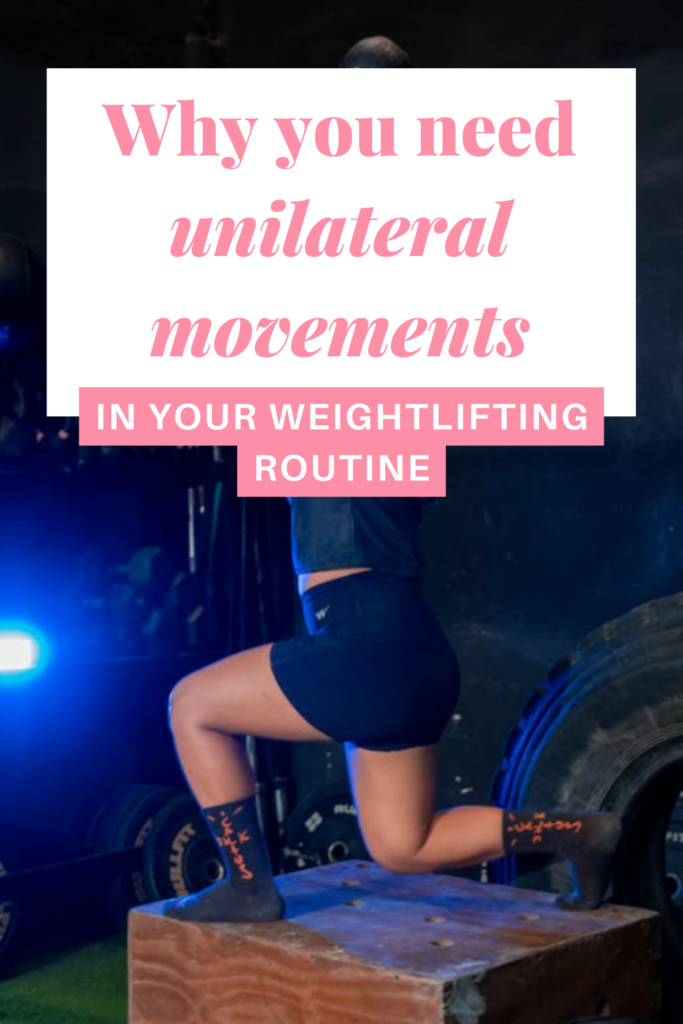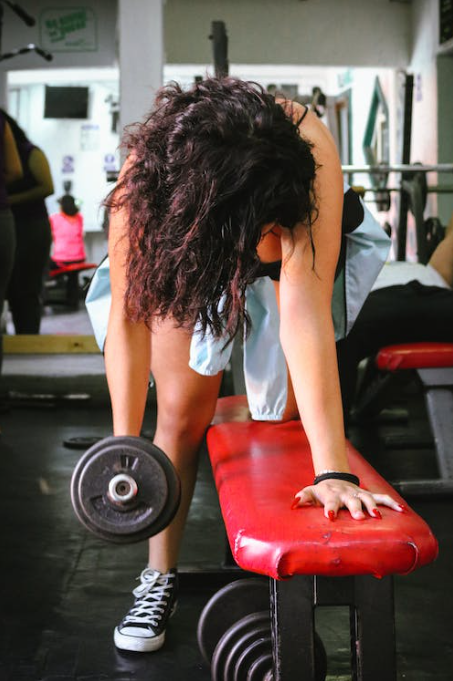Most likely, if you lift weights, you’ve probably heard of the terms “unilateral” and “bilateral”. These terms describe exercises in the gym.
However, you might not be familiar with what either of these terms means.
That’s why I’m here, to help explain it to you. When I first started in the gym, I didn’t prioritize learning all the fancy gym terms. I didn’t think I needed them and was mainly just focusing on lifting weights.
However, I’ve learned now that understanding the exercises you do on a better level will help you become a much better lifter.
Even if you’re just starting out in the gym, it’s never too soon to start developing a better understanding of the exercises you’re doing.

Why it’s important to understand unilateral movements in the gym
If you want to become a better lifter, it’s extremely important for you to expand your lifting knowledge.
The more you know about the gym, the more you can train with intention.
It becomes much easier to design a workout plan when you understand how certain exercises work the way they do. Doing this will allow you to select exercises and design a routine that’s best fit for your goals.
The key here is to develop a deep level of understanding of how certain movements stimulate muscle growth differently.
As well as understanding what purpose each movement serves in terms of making progress.
This will help you design a training routine that works best for your goals. Allowing you to be much more efficient with your training.
What are unilateral movements
Unilateral movements are exercises that work only one side of your body at a time.
Something like a single leg exercise or a single arm exercise. Where one side of your body is isolated while the other side provides support.
In order to identify if an exercise is a unilateral exercise, it’s essential to recognize how much of your body is working at once.
If both your left and right sides of your body are working, then this would be considered a bilateral exercise.
Whereas if you break up the exercise separately onto both sides of your body, this is a unilateral exercise.
If you’re still a little confused about what this means, the easiest way to determine if an exercise is a bilateral exercise is to look at how many sets you do.
For example, if only one set completes your total set for an exercise, then this is a bilateral movement. Let’s say you’re doing squats, you would do one set and your first set is done.
Alternatively, maybe you need to do one set on each side of your body, for a total of two sets, to complete one set of the exercise. Now let’s say you’re doing lunges. You would need to do one set on your right leg and one set on your right leg in order to complete the first set.
This would be an example of a unilateral movement.
Some examples of my favorite unilateral movements
-Front foot elevated lunges
-Bulgarian split squats
-Dumbbell rows
-Cable lateral raises
-Single-arm overhead tricep extensions
-Single leg leg press
Along with many, many others.
The benefits of doing unilateral movements

Unilateral movements provide many benefits when you incorporate them into your weight training routine.
Some of the benefits are:
Increased muscle growth
Incorporating unilateral exercises into your workout routine is a great way to increase your muscle growth.
Because these movements are done on just one side of your body, they provide a new way to active and engage your muscles.
This is because in some areas of your body there are smaller muscles that sit deeper, covered up by bigger muscles.
Usually, these smaller muscles don’t activate as much during normal exercise. This is because the bigger muscles covering them are often more active during conventional movements.
If you think about it, it makes sense why these bigger muscles are bigger and more active. It’s because they engage all throughout the day. When performing daily activities and common exercises.
As a result, different training styles, like incorporating unilateral movements, are required to active the harder to reach muscles.
Because you’re performing the exercise on only one side of your body at a time, unilateral movements require that your body balances itself.
As a result, those smaller, deeper muscles have the chance to become activated, since they’re now needed to help balance and stabilize your body.
This causes much more muscle engagement in all the muscles in the area that you’re training.
An example of how this works
Let’s use your glutes as an example to explain this.
If you’re trying to grow your glutes, you most often hear people telling you to do exercises like squats and hip thrusts.
And although these are good, doing them alone won’t give you the fully developed muscles you’re looking for. Instead, it’s better to pair them with exercises like single leg hip thrusts and front-foot elevated lunges.
These unilateral movements in combination with the bilateral ones will activate the muscles deep within your glutes. This will allow these muscles to engage and grow.
Then, this will not only grow these muscles, but also push out the bigger muscles above them.
Doing this will help you create fuller, more defined looking muscles.
Unilateral movements can help you improve your bilateral movements
Unilateral movements help strengthen bilateral movements because they engage and strengthen new muscles. This helps you increase your overall strength.
That’s why if you’ve hit a weightlifting plateau or feel stuck in your routine, one thing you can do is start doing more unilateral movements.
This will help mix up your routine as well as start strengthening a variety of muscles.
For example, let’s take a look at squats.
Let’s say you’ve been trying to improve our squat for awhile now, however, you’ve found yourself continually stuck at the same weight.
No matter what you try, nothing works to help you break through this plateau. Whether it be training with higher reps and a lower weight, increasing time under tension, or anything else. Nothing seems to work.
Well, incorporating unilateral movements is another way to overcome this. In this case, incorporating something like a single-leg leg press or other single leg exercises can help you break through your squat plateau.
Doing these unilateral exercises will activate new muscles in your legs that don’t typically work during your squats. This will help you gain more strength in these muscles and overall more strength in your legs.
Eventually, with time and consistency, this will help you surpass your plateau. You’ll be making new break throughs in the gym in no time.
Your muscles will look better
As I had mentioned earlier, training and engaging more smaller muscles will create a better appearance for all your muscles.
Think about it, if you want to look the best and your muscles to look the fullest, wouldn’t you want to train all the muscles you possible can in a certain area?
Unilateral movements are what can help you do just that.
As more muscles are activated during these movements, you train the smaller muscles beneath the larger ones as well as the larger ones.
And, as the smaller ones grow, they’ll either fill out the empty spaces that resulted from them being smaller. Or, they’ll push out the larger muscles above them which will make the area look larger.
Either way, training unilaterally will help develop more of the muscles in a given area than just bilateral movements.
With more muscle development, comes fuller, more defined looking muscles.
You’ll be overall more athletic
When you’re doing unilateral movements, only one side of your body is working at a time. Because of this, the other side of your body, along with the rest of your body, needs to be working to stabilize yourself.
As the rest of your body works to stabilize itself, more muscles are being activated and engaged.
When this happens, number one, your balance will improve, since you’ll be performing movements that require you to lift heavy and balance.
And number two, your core will strengthen as it stabilized your body.
Core strength and balance are two essentials when it comes to being athletic.
Because of this, increasing your balance and core strength are two of the best ways to improve your overall athleticism.
Both of these will make you more agile, quicker, and improve your ability to move athletically. All simply from doing exercises that only work one side of your body at a time.
Takeaways
Unilateral movements are the key to having a well-rounded weightlifting routine.
If you want to improve your strength, overall appearance, and athleticism, then consider implementing these into your workout routine.
Before you know it, you’ll be training unilaterally and bilaterally in the gym. Then, you’ll see more progress than ever before!
More of my posts on women’s weightlifting: